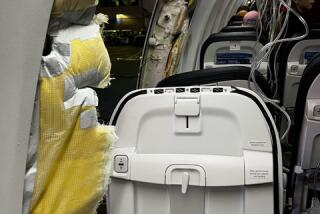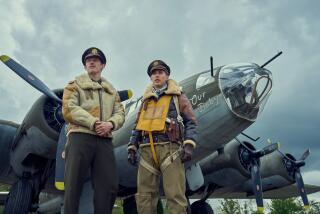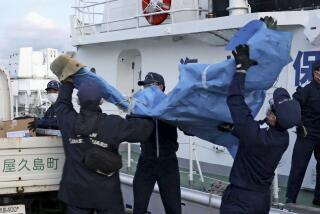Violet Cowden dies at 94; civilian WASP aviator during World War II
Violet Cowden never lost her love of flying, a passion born when she was a young girl envying the hawks soaring above her family’s South Dakota farm in the 1920s.
When she was a young first-grade teacher learning to fly out of an airfield in Spearfish, S.D., in the early 1940s, her students always knew when she had been flying because she was so happy.
Her love of flying only increased when she joined the Women Airforce Service Pilots (WASP) during World War II. And although her career as a pilot ended after her wartime service, her enthusiasm for flying never let up.
Indeed, Cowden gleefully co-piloted a World War II-era P-51 Mustang with dual controls and flew from San Bernardino to Orange County last year when she was 93.
As she put it in a 2010 documentary about her life in the sky: “I always say the worst thing about flying is coming back to earth. That’s the hardest thing for me. I would stay up, I would — but you do run out of gas.”
Cowden, a former president of the WASP veterans organization whose experiences and indomitable spirit inspired later generations of female pilots, died April 10 of congestive heart failure at Hoag Memorial Hospital Presbyterian in Newport Beach, said her daughter, Kim Ruiz. She was 94.
Cowden was 26 when she earned her WASP silver wings in 1943.
“I joined because of love for the country,” she told The Times in 1993, “and I thought maybe I could contribute something to the war effort.”
Of the 25,000 women who applied for the WASP training program, 1,830 were accepted and 1,074 graduated.
As civilian pilots under contract to the military, the WASP fliers freed up male pilots for combat missions.
Members ferried pursuit aircraft (fighters), bombers and transport planes from factories to military bases and points of embarkation within the United States — and performed other duties, such as towing targets for antiaircraft gunnery practice and flying as engineering test pilots.
Cowden flew 19 different types of aircraft, including fighters. The P-51 Mustang was her favorite, she said in the 1993 Times interview.
Once, she recalled, she got a P-51 up to more than 400 mph when she raced a Navy pilot from Columbus, Ohio, to Newark, N.J. “I just stayed ahead of him all the way,” she said.
Cowden also delivered the first P-51 to the Tuskegee Airmen, the nation’s first black military air unit.
The dangerous work of the WASP — 38 pilots died during training and on active duty — wasn’t always appreciated.
“I landed an AT-6 in Kansas City,” Cowden recalled in a 2010 interview with the Orange County Register. “The commanding officer at the field heard that a woman had flown it in and wouldn’t accept it. I just ignored it. That’s all you can do.”
Cowden later figured she logged enough miles to have flown around the world 55 times during her wartime service.
One of the saddest days of her life, she said in the 1993 Times interview, was when the WASP was deactivated in December 1944.
“The war was winding down and the men were coming back and wanted their jobs back,” she said. “I felt a lot of resentment.”
In “Wings of Silver: The Vi Cowden Story,” a 34-minute documentary by Mark and Christine Bonn of Hermosa Beach, Cowden said: “I think the shock of the whole thing was that I thought we were doing something so important and then all of a sudden it’s not. It’s like you’ve been doing all of this for nothing.”
After the force was deactivated, Cowden said, “we had our commercial license and if the airlines would have hired women at that time I probably would have been flying the rest of my life.”
Instead, she got a job with TWA in New York City, where she worked at the ticket counter for about a year. “But that was so awful,” she said, “because here the planes were flying and you wanted to fly and you couldn’t and it just wasn’t satisfying.”
She later co-owned a ceramics shop in Lynwood, got married and became a mother. After moving to Huntington Beach with her family in 1972, she operated the Teachers Resource Center in the Huntington Beach City School District.
It wasn’t until 1977 that members of the WASP were recognized as military veterans and given limited benefits.
In 2010, Cowden joined some 200 other surviving WASP veterans in Washington, where they received Congressional Gold Medals for their wartime service.
During question-and-answer sessions at film festivals where “Wings of Silver” has been screened, Christine Bonn said last week, “the first question everybody asks is, ‘Where did you find this amazing woman?’ They’re all blown away and inspired by her.
“Vi really embodies all the aspects of the WASP — their spirit of adventure, courage and can-do spirit.”
Cowden, who was born in a sod house on a farm in Bowdle, S.D., on Oct. 1, 1916, celebrated her 76th birthday in 1992 by putting a new twist on her old love: skydiving out of an airplane in tandem with an instructor at 12,500 feet.
She jumped again in 2005 when she was 89, that time with the Army’s elite parachute team, the Golden Knights.
“Vi found joy in every day,” said Katherine Landdeck, an associate professor of history at Texas Woman’s University, which houses the WASP archives. “She loved flying and being in the air and sharing not just the WASP story, but the love of flight with everyone.”
Cowden’s husband, Scott, died in 2009.
In addition to her daughter, she is survived by two sisters, Betty Niese and Lillian Riede; and three grandchildren.
A memorial service is pending.
More to Read
Start your day right
Sign up for Essential California for the L.A. Times biggest news, features and recommendations in your inbox six days a week.
You may occasionally receive promotional content from the Los Angeles Times.






